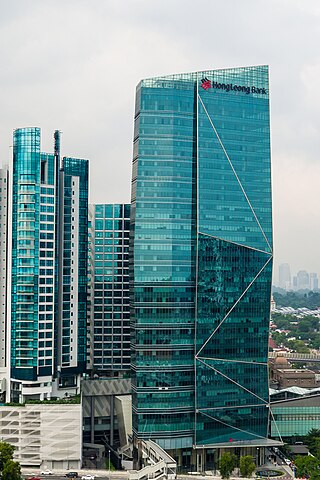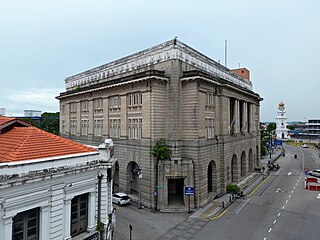OCBC Bank Limited, formerly Wing Hang Bank Limited and OCBC Wing Hang Bank Limited, is a licensed bank with its head office in Hong Kong. Since 15 October 2014, Wing Hang Bank has been a wholly-owned subsidiary of the Oversea-Chinese Banking Corporation (OCBC) headquartered in Singapore. The acquisition of Wing Hang has given OCBC a network of about seventy branches spanning Hong Kong, Macau and mainland China to add to OCBC's existing operations in Hong Kong and China.

Tan Sri Khoo Teck Puat was a banker and hotel owner, who, with an estimated fortune of S$4.3 billion (US$3,195,953,500), was the wealthiest man in Singapore at one point. He owned the Goodwood Group of boutique hotels in London and Singapore and was the largest single shareholder of the British bank Standard Chartered. The bulk of his fortune came from shares in Standard Chartered, which he bought up in the 1980s to help thwart Lloyds Bank's proposed acquisition which many financiers deemed hostile. The Goodwood Park Hotel in Singapore, built in 1900, is a restored historic landmark.

Oversea-Chinese Banking Corporation Limited, abbreviated as OCBC, is a Singaporean multinational banking and financial services corporation headquartered at the OCBC Centre.

Raffles Place is the centre of the Financial District of Singapore and is located south of the mouth of the Singapore River. It was first planned and developed in the 1820s as Commercial Square to serve as the hub of the commercial zone of Singapore in Raffles Town Plan. It was renamed Raffles Place in 1858 and is now the site of a number of major banks. It is located in the Downtown Core within the Central Area, and features some of the tallest buildings and landmarks of the country.

Hong Leong Bank Berhad is a major public listed banking group in Malaysia.

Tan Sri Dato' Lee Kong Chian, also known by his alias Lee Geok Kun, was a prominent Chinese Singaporean businessman and philanthropist based in Malaya and Singapore between the 1930s and the 1960s. He was the founder of the Lee Foundation and one of the richest men in Southeast Asia in the 1950s and 1960s. He was also a son-in-law of Tan Kah Kee, another well-known Chinese businessman and philanthropist based in Southeast Asia. He is affectionately known today as the "founding father" of Oversea-Chinese Banking Corporation.

The Ho Hong Bank (1917–1932) was a Malayan bank, established to provide banking services that, until 1912, were solely delivered by European banks. The bank was founded in 1917 and in 1932 merged with two other banks in Singapore to form the Oversea-Chinese Banking Corporation.

The City Hall is the local government headquarters of George Town within the Malaysian state of Penang. Built by the British, it now serves as the seat of the Penang Island City Council and was previously the seat of the George Town City Council.

United Overseas Bank Limited, often known as UOB, is a Singaporean regional bank headquartered at Raffles Place, Singapore, with branches mostly found in Southeast Asia countries.

Beach Street is a major thoroughfare in George Town within the Malaysian state of Penang. Part of the city's central business district, it is also one of the oldest streets in Penang, having been created soon after the founding of the state by Captain Francis Light in 1786.
Bank of Singapore is the private banking arm and a wholly owned subsidiary of Oversea-Chinese Banking Corporation (OCBC), Southeast Asia’s second largest bank.

The George Town Central Business District (CBD) is the financial and political centre of the city of George Town, the capital of the Malaysian state of Penang. The financial district, which was first envisioned by the Penang Island City Council's Local Plan 2030, lies entirely within the city centre, and is home to much of the city's banking and financial services. The term CBD is often used interchangeably with Downtown George Town, encompassing both the historic core and modern sections of the city centre.

Light Street is the oldest road in the city of George Town within the Malaysian state of Penang. It was named after the founder of Penang, Captain Francis Light. As the epicentre of George Town, the street was created soon after Light established the settlement in 1786 and has been serving as a major thoroughfare within the city centre ever since.

Farquhar Street is a major thoroughfare in the city of George Town within the Malaysian state of Penang. Created in the late 18th century, the road forms part of the city centre's civic precinct, and is notable for the colonial buildings built under British rule. These include some of the most significant civic, religious, and commercial buildings of Penang, such as Penang High Court, Penang State Museum and Art Gallery, St. George's Church, Church of the Assumption, and Eastern & Oriental Hotel.

George Town, the capital city of the state of Penang, is the second largest city in Malaysia and the economic centre of the country's northern region. The history of George Town began with its establishment by Captain Francis Light of the British East India Company in 1786. Founded as a free port, George Town became the first British settlement in Southeast Asia and prospered in the 19th century as one of the vital British entrepôts within the region. It briefly became the capital of the Straits Settlements, a British crown colony which also consisted of Singapore and Malacca.
The Chinese Commercial Bank was a Malayan bank established in Singapore in 1912. It was also the first Hokkien bank in Singapore. In 1932, the bank was merged with Ho Hong Bank and Oversea-Chinese Bank to form the Oversea-Chinese Banking Corporation.

The Standard Chartered Bank building is a historical building in George Town within the Malaysian state of Penang. Completed in 1930, the office building, situated at Beach Street within the city's Central Business District (CBD), was one of the tallest in the city at that time. It served as the Penang branch of Standard Chartered until 2017, after which the bank relocated to its new premise down the street. The building has since been reopened as Spaces Beach Street, one of IWG's coworking spaces in Malaysia.

The Bank of China Building is a historical building in George Town within the Malaysian state of Penang. Completed in 1905, the office building, situated at Beach Street within the city's Central Business District (CBD), originally served as the offices of the Netherlands Trading Society (NTS). Following a series of acquisitions, the building changed ownership multiple times. It was acquired by Algemene Bank Nederland, then by ABN AMRO and the Royal Bank of Scotland. Eventually, it was sold to the Bank of China, which relocated its Penang branch to the building in 2017.

The HSBC Building is a historical building in George Town within the Malaysian state of Penang. Opened in 1951, the office building, situated at Downing Street within the city's Central Business District (CBD), houses the Penang branch of HSBC.

The Foo Tye Sin Mansion is a mansion in George Town within the Malaysian state of Penang. Built in 1875, the building is situated at Light Street within the city's Central Business District. It was originally the residence of Chinese tycoon Foo Tye Sin. In 1986, the building was acquired by MUI Group, and it currently serves as a branch of Hong Leong Bank.




















